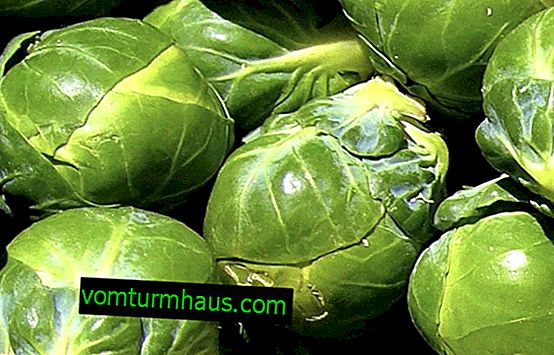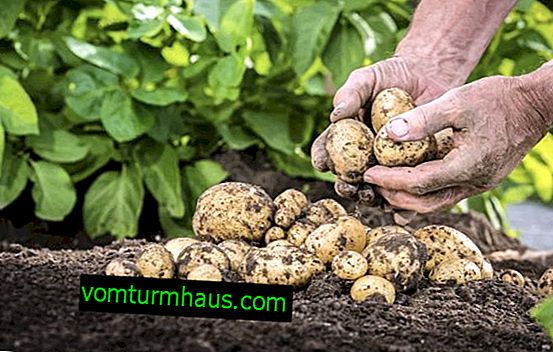When to harvest Brussels sprouts
Most gardeners plant so-called white cabbage in their plots, but there are many who prefer colored varieties and unusual Brussels sprouts. What you need to know about the peculiarities of the ripening of the last option and how to properly carry out harvesting - this will be discussed later.
What determines the maturation and harvest of Brussels sprouts
Each summer resident independently decides when to collect cabbage from the garden, but in any case, the cabbage should reach the stage of full maturity. Brussels varieties are slightly different from white varieties, therefore, in the issue of the exact date of collection, it is important to take into account the characteristics of the cultivated variety, the climatic characteristics of the growing region and the time of transplanting. Consider each of these criteria.
Varieties
If you decide to plant early or mid-ripening (up to 100 days of ripening) varietal cabbage varieties on the bed, there is every chance to try the fruits in mid-summer. Such popular varieties and hybrid forms of plants include:
- Long Island;

- Franklin;

- Oliver;

- Dolmik.

Important! The process of ripening the culture should always be kept under control, because the ripened specimens will be unsuitable for consumption, and the overripe ones will quickly crack and begin to rot. A head suitable for cutting is always dense and creaks slightly when squeezed.
Climate
The climatic features of a particular area is one of the first criteria that affects the harvest time of any crop. Of course, in the central part of the Russian Federation, fruits ripen faster than in Siberia, so if you are going to grow Brussels sprouts in harsh regions, you will have to take care of the necessary shelter. On average, the difference in harvest time between different climatic regions is no more than 2 months.
Landing time
If transplanting seedlings in open soil was carried out in late April or early May, then most likely you will be able to collect heads in September. In cases when young plants had to be transplanted, they had to wait until June, you can remove heads of cabbage no earlier than October-November.

Did you know? In the wild, Brussels sprouts do not grow, so there is every reason to believe that the first samples were obtained artificially, based on the leaf variety of this crop. However, in the VIII-XIV century, a certain similar plant grew in the gardens of Belgium, which is why the new species was named after the capital of this state.
The main signs of ripening brussels sprouts
Based on the date of planting the crop, you can calculate the approximate time for harvesting, but in order to determine the exact time, it is worth considering the external characteristics of the plants. The first fruits are harvested already when they reach the size of a walnut, and their two or three lower leaves change color to yellow (it is advisable to immediately tear off such leaf blades). It is not worth it to overdo the cabbage on the bush, otherwise the upper heads of cabbage will form much more slowly.
How to collect brussels sprouts
As already noted, the harvest of Belgian cabbage will have to be collected in several stages, as its fruit ripens. You can speed up this process by introducing nutrients into the soil, but even in this matter you need to be very careful not to oversaturate the soil with organic matter and not to provoke chopping of heads of cabbage.

Did you know? In Germany, this variety of cabbage was nicknamed the beautiful word "rosenkol" - rose cabbage.
On average, with a warm autumn and proper agricultural cultivation techniques, fruit cutting can be done until November, each time removing 10-15 new heads of cabbage. With such a volume of harvest, for one small family, only 3-4 plants will be enough, which will fully guarantee a sufficient amount of nutrients that enter the body along with cooked heads of cabbage.
Brussels sprouts can be harvested in any weather. True, if there were frosts at night, then in order to preserve the natural nutritional and taste properties of a vegetable, it is better to collect fruits in the afternoon or late in the evening. In a few hours, the cabbage will gradually freeze and slightly dry, which is important for further successful storage. As for the equipment used, then you do not need any special devices for harvesting heads: they are very easy to break out with your fingers or cut with a sharp short knife.
Video: Growing and picking Brussels sprouts
Harvest Storage Rules
Harvested heads of Brussels sprouts do not have a long shelf life, so in the first days after harvesting, you must use the fruits for food or process them for longer storage throughout the winter.
Important! When used simultaneously with whole grains, Brussels sprouts may well replace the animal protein necessary for the body. It is almost completely absent sodium and fat, but vitamins A, K, C, B6 and B9 are enough to normalize the basic functions of the body and even increase male potency.
You can save fresh cabbage only in rooms with an air temperature not exceeding + 2 ... + 5 ° C, after sprinkling the lower parts of cut stems (along with heads of cabbage) with clean sifted sand in advance. In this form, the fruits are able to lie in the basement or on the balcony for up to two months, without losing their main qualities during this time.

Storage of Brussels sprouts in the refrigerator is possible for no longer than ten days, and then, if you do not forget to put the fruits in a hole in plastic bags or in a special container with a valve designed for storing such products. If there is a place in the freezer of the refrigerator, it’s even better, because washed, dried and frozen fresh fruits retain their nutritional qualities better than others and can safely lie down until a new crop.
Important! Residents of Siberian regions do not have to collect Brussels sprouts from the garden - cold and frosty winters will play the role of a freezer. You only need to pour snow on each bush and check the absence of thaws in order to calmly cut the remaining heads of cabbage in spring.
If you have never tried Brussels sprouts, be sure to plant this variety in your area.








